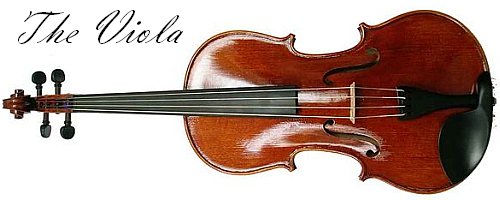The Viola
The Viola
Within the musical instrument classification of chordophones the viola holds a special place where its sound and character uplifts the soul! Its role in the string trio, quartet and quintet is as vital as its role in the string orchestra and in the string section of the full orchestra . It is one of the primary instruments of the string trio, string quartet and quintet as well as the string orchestra. The viola also holds a permanent place in the string section of the full symphony orchestra. The viola performs just as effectively as either a solo instrument or as a member of these string instrument groups.
When the viola is part of standard string instrument arrangement, such as those mentioned above, its range falls in the middle or it sits in between the violins which are a fifth above and the cello which sits an octave below the viola. In this way the viola fills in and enriches the sound of the string instrument group. In this way it is considered to be the middle voice of the string section of the orchestra, quintet and quartet. Sometimes a composer will write a melodic passage for the viola thus allowing the unique tonal qualities of the viola to stand out and be beautifully expressed.
There are a lot of similarities between the viola and the violin. For example, from a distance the viola looks very much like a violin only larger in size. It is held and played in a very similar manner as the violin. There are some structural and construction differences due to its increased size and there are more options available to the luthier when considering the size ratios of the various components or parts of the viola.
The strings used on a viola are thicker than those used on the violin therefore there is a requirement for additional finger and bow pressure when playing this instrument. Also, the viola is fretted using the left hand and the performer has the choice, as related to the desired articulation designated in the composition, to pluck the strings with the fingers of the right hand, the left hand and/or to play short through extended durations of a musical note by using a bow. The bow allows a wider range of additional sound possibilities through the use of various bowing techniques. The bow is typically held in the right hand, identical to playing the violin.
Many claim that the sound qualities of the viola are mournful in nature. To a degree, this comment is true however the complete capabilities of the viola and its range of sonic character, of the possible sounds it is able to produce, goes way beyond this rather limited idea of its “mournful” sound producing possibilities. Between the use of various fingering techniques, a wide variety of bowing techniques and by playing on different parts of the viola, the range of the viola is extensive. With these ideas in mind, you can come to know the rich and full sounds of the viola with a much deeper meaning and useful intent as well as the options available to the composer who writes music for this instrument.
The video below reflects the unique sonic characteristics of the viola as we have been stating. The performance of “Fantasia for Solo (unaccompanied) Viola” composed by Nick Ariondo for virtuoso violist John Acevedo is an absolutely amazing composition and performance reflecting the sonic range, versatility and the wide range of available performance techniques the viola offers as we have previously explained. Ariondo opens the video with a brief explanation of some of the techniques used in the composition as well as a comparison to the Paganini style of virtuosic composition.
We would strongly urge that you read the video liner notes as posted as they are very informative and educational in nature. The viola is an amazing instrument and the performance by John Acevedo is virtuosic and frankly, quite incredible. This is the type of video that can long serve the student of the viola.
Consequently, we want to extend a huge thank you to Nick Ariondo and John Acevedo and to YouTube for making this video possible for use through their non-commercial, educational rules for embedding videos.
We hope that you have enjoyed this brief introduction to the viola and that maybe you will be so enticed as to seek out additional information supporting the decision to accept the viola as your instrument of choice.
The Viola
Photo Credits – The photograph of the viola is listed in the Wikipedia article about the viola and captured on 06/23/2011. The owner of the photograph makes the claim that it is in the public domain and available for any use. Our intent is clearly for use in this educationally based article about the viola.




